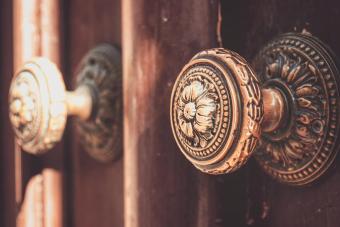
Whether they're made out of stamped metal, painted porcelain, or cut crystal, antique doorknobs imbue a sense of old-world energy into any home or business that they're found in. Since these doorknobs can be reused in modern settings, there are many more types of people interested in buying these pieces than just antique collectors. So, if you're wanting to restore an old farmhouse or trying to learn a little bit more about your grandparents' home, take a look at how old types of doorknobs have evolved over time, and where you can look to purchase one today.
Antique Doorknobs Identification
While most people are familiar with the general appearance of old-style doorknobs, some might not be able to pick up on the earliest examples of them as easily. So, it's important to look for a few different characteristics when you're trying to assess a potential antique doorknob for its origin and value.
Antique Doorknob Shapes
While not all antique doorknobs are perfectly round, they do have a general rounded shape and fit well into the palm of your hand. Some of the earliest old-fashioned doorknobs are actually rather small and come equipped with a long metal rod attached to the end. Historically, this rod allowed people to stick the knob into the mortise lock mechanism - an incredibly significant development in the history of security and safety - and turn it. Thus, a lot of old doorknobs you'll find loosely piled in antique store bins will come with these long rods attached. In addition, design features like the rods can help you identify where and when your antique doorknob is from:
- Pressed glass knobs were popularly used between the 1820s to the 1850s.
- Cut glass was popularly used during the 1860s through to 1910.
- Wooden knobs were used from about 1885 to 1910.
- Imported chinaware knobs were first used in the 1850s.
- Cast metal became widely available in the mid-1840s, and so doorknobs were quickly crafted out of the material
- In 1870, a method for compression casting allowed the Victorians to have the detailed casting indicative of their residential style.

Antique Doorknob Styles
Since the incorporation of doorknobs into building design really took off during the 19th century - in fact, over 100 doorknob patents were granted between 1830-1870 - doorknobs were crafted out of a variety of different available materials, like brass, bronze, gold, steel, porcelain, crystal, and glass. When it comes to antique doorknob identification, here are some of the different characteristics of historic and vintage doorknobs to be on the lookout for:
- Early 19th Century - On the whole, doorknobs that were used prior to the 1840s were simply designed with functionality in mind.
- Victorian Era - This period is considered the height of decorative doorknobs and other residential hardware; doorknobs from this period come in unique shapes, with filigree, scalloping, etchings, hand-painted scenes, and more to decorate their surfaces.
- Edwardian Era - Just following the Victorian period, doorknobs made during this time become a bit more refined and less ostentatious than those made during the previous era.
- World War I - Interestingly, World War I directly inspired the widespread use of glass doorknobs due to metal rationing during the period.

Commercial vs. Residential Doorknobs
An important aspect of identifying antique doorknobs is determining what type of building the doorknob was intended to be used for. Commercial residences were more likely to have customized doorknobs such as ones with business monograms or logos stamped onto their faces. For example, the St. Nicholas Hotel, which was built during the height of the Gilded Age, has doorknobs inscribed with its initials, which are accompanied by a Celtic knot motif. Similarly, the socially elite were able to afford luxurious doorknobs encrusted with precious metals and artistry to outfit their extravagant homes.

Antique Doorknob Values
Genuine antique doorknobs can be surprisingly expensive, particularly since they're often used to maintain old buildings and residences through historic preservation practices. Generally, antique doorknob values are highly dependent on their style, the manufacturer, the materials made to create them, and what period they were created during. On the whole, antique doorknob values can range from as little as $10 to as much as $200. Additionally, Victorian doorknobs are particularly desirable because of their unique designs. For example, a pair of 1897 Reading Hardware cast bronze doorknobs is listed by one business for a little over $100. Thankfully, there's an abundance of historic hardware sellers and businesses that you can purchase both authentic antique doorknobs and quality reproductions from, so you shouldn't have any trouble finding the perfect replacement doorknob for your fixer-upper.

Open Your Heart to Antique Doorknobs
Antique doorknobs acted as the key to historic locks, and they can also act as the key to your own heart with their minute design details and old-world charm. So, whether you're looking to spruce up your childhood home or are looking for a way to customize your modern apartment, browsing for an antique doorknob instead of buying a boring replacement at the local hardware store is a great way to do so.







